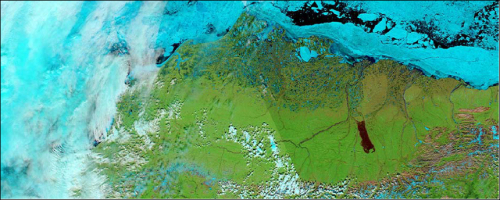Largest recorded tundra fire yields scientific surprises

In 2007 the largest recorded tundra fire in the circumpolar arctic released approximately as much carbon into the atmosphere as the tundra has stored in the previous 50 years, say scientists in the July 28 issue of the journal Nature. The study of the Anaktuvuk River fire on Alaska's North Slope revealed how rapidly a single tundra fire can offset or reverse a half-century worth of soil-stored carbon.
Tundra soils store huge amounts of carbon hundreds to thousands of years old. Intact, the layers of organic soil insulate the permanently frozen ground, called permafrost, below.
"Fire has been largely absent from tundra for the past 11,000 or so years, but the frequency of tundra fires is increasing, probably as a response to climate warming," said co-author Syndonia "Donie" Bret-Harte, an ecosystem ecologist at the University of Alaska Fairbanks Institute of Arctic Biology.
The Anaktuvuk River fire burned 1,039 square kilometers (401 square miles), an area roughly the size of Cape Cod and visible from space, and released more than 2.1 teragrams (2.3 million tons) of carbon into the atmosphere. Radiocarbon dating of the soils revealed the maximum age of the soil carbon emitted from the fire was 50 years.
"The amount of carbon released into the atmosphere from this fire is equivalent to the amount of carbon stored by the global tundra biome," said lead author Michelle Mack, a biologist from the University of Florida. "This was a boreal forest-sized fire."
Little is known about the effects of fire on carbon storage and cycling in tundra ecosystems. Cool, wet soils underlain by permafrost are thought to restrict fires to aboveground plants and ground-level plant litter leaving the carbon stored in soils relatively intact. As arctic summers get warmer and dryer, so too do the soils, which are highly flammable and able to burn more deeply when dry.
"If the frequency of these fires remains at long intervals, 80 to 150 years, then the tundra has time to recover," Bret-Hart said. "If these fires occur more frequently, say every 10 years or so, then the landscape cannot recover."
The Anaktuvuk River fire was started by a lightning strike in July 2007. "Normally we would expect the fire to go out in the moist soil, but this summer was so dry that the fire didn't go out and strong winds in September caused it to burn a very large area," said Bret-Harte, who noted that 40 percent of the fire was classified as a severe burn – high for a tundra fire. The fire was visible 24 kilometers south at the IAB Toolik Field Station, where the scientists were working, as a wall of smoke on the horizon.
In addition to the direct release of carbon into the atmosphere, tundra fires are important because of the potential feedbacks to global climate change. "These fires could be a radical and very rapid positive feedback to atmospheric carbon dioxide," said Mack.
Fire removes organic material that insulates permafrost from warm summer temperatures. Insufficient insulation can lead to thawing permafrost, destabilization of the ground surface and exposure of deep soil carbon to decomposition and release into the atmosphere – ultimately amplifying high-latitude warming.
According to the authors, their observations of carbon loss from the Anaktuvuk River fire support the idea that tundra fires have the potential to release large amounts of carbon and decrease landscape carbon stocks, having an immediate impact on atmospheric carbon and climate.
Provided by University of Alaska Fairbanks

















